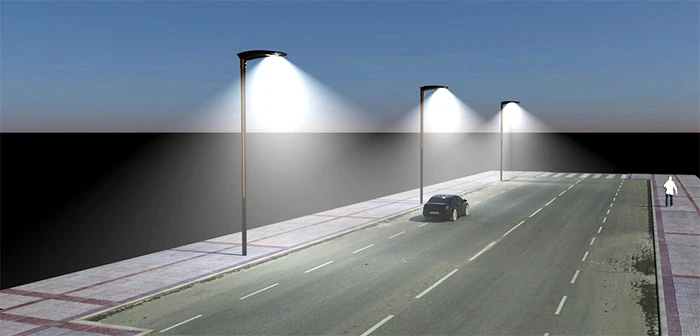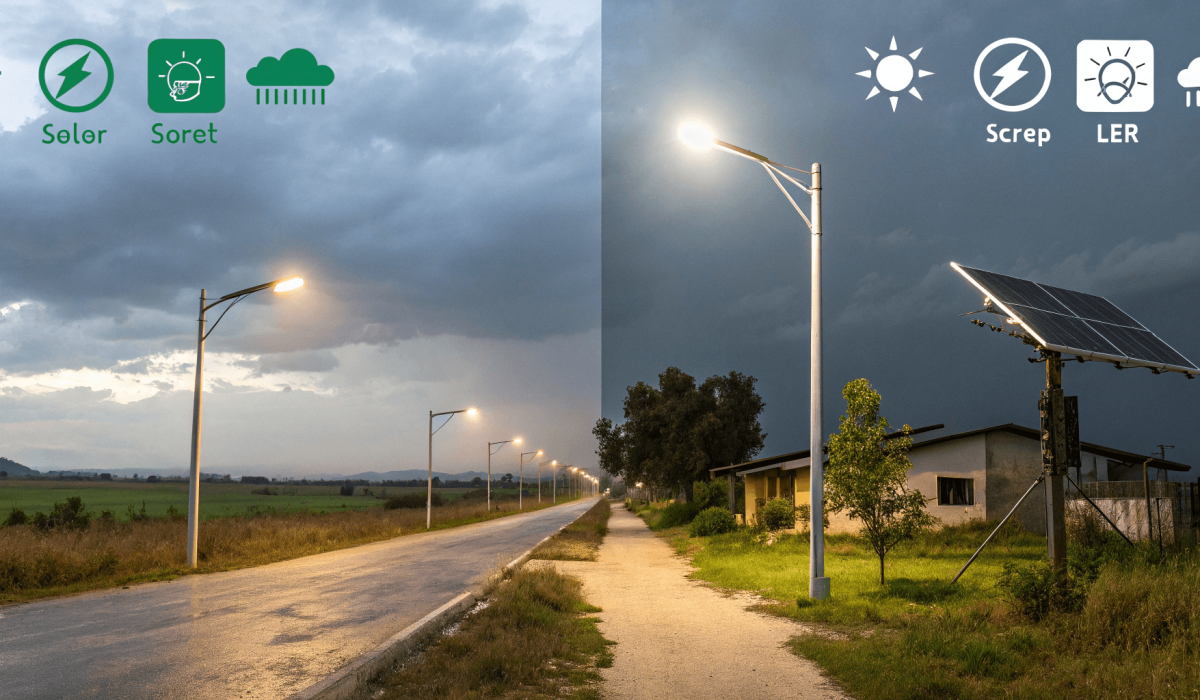A lot of people think solar street lights are a “set it and forget it” miracle. No bills, no wires, just clean energy. Sounds great, right?
Honestly, if you live in a sunny region and your streets don’t demand stadium-level lighting, solar lights are a brilliant choice. But they’re not perfect—and pretending they are will cost you.
Let’s break it down—from how they work, to what they can and can’t do—so you don’t waste money on the wrong setup.
Why Are Solar Street Lights Gaining Traction?

I remember overseeing a rural lighting project in northern Uganda. The crew finished installing a full stretch of solar street lights in a single day—without digging a single trench. No noise, no cables, no heavy machinery.
That’s the real appeal: energy independence, fast setup, and freedom from utility politics.
Solar street lights work like this: during the day, solar panels soak up sunlight, converting it into electricity that gets stored in a battery. Come nightfall, the system uses that stored energy to light up the LED fixture. Some units even include sensors that dim the lights when no one’s around or boost brightness when they detect motion.
Sounds simple? It is. But don’t confuse simple with foolproof.
Weather, shade, incorrect installation angles—these all reduce energy generation. And don’t forget the batteries: they wear down over time, and cheaper models can start failing in just 2–3 years. So if you’re thinking about going solar, the key is good design and even better planning.
How Do Solar Street Lights Actually Work?
Let me break it down in plain terms—because all that “PV panel + controller + battery” jargon doesn’t help much if you’re just trying to light up a street and keep it on all night.
In essence: during the day, the panel charges the battery; at night, the battery powers the LED light. Simple enough, but it’s the details that make or break your system.
We’ll walk through each component based on what I’ve seen in the field—some of which might surprise you.
Dive deeper into the components—and what can go wrong
Solar Panel
This is your sun sponge. If it’s not tilted right or gets shaded—even a little—it can lose up to 30% efficiency. I once saw a system installed under a billboard. Beautiful idea, but half the panel sat in the shade all day. Guess what happened at night? Nothing.
Battery
Think of this as your storage tank. Most setups use either GEL or lithium (LiFePO₄) batteries. GEL is cheaper but dies faster—especially in hot or humid areas. Lithium costs more, but in my experience, it’s worth it. One client tried saving money with GEL; by year three, they had to replace half their batteries.
LED Fixture
Bright, efficient, long-lasting—but only if sized properly. Don’t expect the same intensity as a grid-fed 250W high-pressure sodium lamp. Some controllers dim the LEDs after midnight to conserve power, which works fine unless you’re lighting a highway.
Controller
It’s the brain of the operation. It tells the system when to charge, when to light up, and when to sleep. The cheap ones fail first—especially in rain or extreme heat. I’ve opened boxes and found circuits rusted after a single rainy season.
The trick is balance. You can’t go all-in on one component and skimp on the others. The whole system has to be designed for the specific location, traffic needs, and sunlight availability. Otherwise, you’ll end up with a system that only works on paper.
What Are the Main Benefits of Solar Street Lights?

You might’ve heard the pitch: “No electricity bills! Easy to install! Environmentally friendly!” And while none of that’s wrong, it can sound a bit too polished. Let me tell you what actually makes solar lights worth it—especially if you’re operating in places like Uganda, Ghana, or even rural China.
Here’s the truth: if you need a reliable light source where the grid is weak or nonexistent, and you want to avoid endless monthly utility bills, solar can be a lifesaver.
Dive deeper into real-world strengths
1. No trenching needed
Digging through concrete or earth just to lay cables? That’s yesterday’s headache. With solar, you just plant the pole and wire up the components. I’ve seen parking lots go from dark to fully lit in a weekend.
2. No energy bills—ever
This one’s obvious but still amazing. You’re not paying monthly electricity costs. Multiply that by 50 or 100 lights, and the savings get serious.
3. Goes where the grid won’t
Remote roads, coastal walkways, dusty rural paths—solar works where extending the grid would cost a fortune. I helped a client light up a remote lodge entrance where poles and cables would’ve added $20,000 in costs.
4. Minimal maintenance
As long as you clean the panels and check batteries every now and then, the system can run for years without major issues. No burnt-out bulbs. No transformers to fail.
5. Modular and scalable
Want to light up one street now and expand later? No problem. Solar lets you scale at your pace. Just add more units as your budget allows.
That said, it’s not all sunshine. Time to look at the darker side—pun intended.
What Limitations Should You Be Aware Of?

Solar lighting sounds amazing until you wake up to a dozen complaints about streetlights going dark after a cloudy week. I’ve been there—and so have many of my clients.
No system is flawless. And solar comes with trade-offs like battery degradation, reduced brightness, and heavy dependence on the weather.
Dive deeper into real-world limitations
Weather dependence is real
Sunlight equals power. Cloudy or rainy conditions = less energy stored. It’s like cooking with firewood: no sun, no “fuel.” If your region has long rainy seasons, you need oversized panels and batteries—adding cost.
High upfront cost
No denying it—solar systems can cost 1.5–2 times more upfront. You save in the long run, but the first invoice might make you gulp. And if you’re tempted by low-cost suppliers? Don’t be. You’ll pay more later in replacements.
Lower brightness for major roads
Most solar setups can’t match the lumen output of a 250–400W grid-powered streetlamp. That’s okay for villages or footpaths—not so much for four-lane roads. I always tell clients: know your lux requirements before you commit.
Battery lifespan
Even with top-quality lithium batteries, expect to replace them after 5–10 years. GEL batteries? Often 3–5 years. If you forget this, your “zero maintenance” light could become a maintenance headache.
Still needs some TLC
Panels get dusty. Wires corrode. Controllers fail. You’ll need basic inspections every 6–12 months. Not a dealbreaker—but definitely not zero-maintenance like some brochures claim.
Solar vs. Traditional Street Lights: A Side-By-Side Comparison
| Feature | Solar Street Lights | Traditional Grid Lights |
|---|---|---|
| Power Source | Sun + Battery | Electricity Grid |
| Upfront Cost | Higher | Lower + trenching and cabling |
| Running Cost | Near zero | Monthly energy bills |
| Installation | Easy and quick | Time-consuming, infrastructure-heavy |
| Brightness | Moderate (OK for small roads) | High (best for highways) |
| Maintenance | Low (battery + cleaning) | Medium (bulbs, wiring, transformers) |
| Best Use Case | Off-grid, rural, parks, paths | Highways, commercial zones |
Where Do Solar Lights Truly Shine?

Solar isn’t a one-size-fits-all solution. But there are situations where it absolutely outperforms traditional lighting—both economically and operationally.
Think remote villages, public parks, unlit walkways, or any area where trenching is costly or impossible. In these contexts, solar isn’t just viable—it’s the better option.
| Application Area | Suitability | Why It Works |
|---|---|---|
| Rural villages | ✅ Excellent | Off-grid, cost-efficient |
| Residential lanes | ✅ Great | Moderate lighting needs |
| Parks & greenways | ✅ Perfect fit | Low activity, motion sensing works well |
| Temporary event zones | ✅ Ideal | Fast deployment, portable if needed |
| Highway intersections | ❌ Not recommended | High brightness needed |
| Urban commercial zones | ⚠️ Risky | May underperform without hybrid backup |
Can Solar Lights Handle Highways?
Here’s where it gets tricky.
Pure solar systems struggle to meet the brightness standards for highways and major roads. You’ll either need oversized components or a hybrid solar-grid setup.
In high-traffic zones, I recommend using hybrid systems: solar handles base load, while the grid steps in during cloudy weeks. But this means more complex installation and higher cost—so weigh that carefully.
If safety and compliance are top concerns, don’t cheap out here. One accident due to underlighting costs more than doing it right the first time.
Conclusion
If you want lighting that’s independent, low-maintenance, and eco-conscious—solar is your guy. But don’t go in blind. Know the limits, plan smart, and don’t fall for the cheapest option.
If you’re building in off-grid, rural, or budget-sensitive areas—solar street lights are not just “good enough.” They might be the best decision you make.
Key Takeaways
- Great for off-grid, remote, or developing zones
- Saves money long-term, despite high initial cost
- Needs design based on sunlight, battery sizing, and usage
- Not suitable for major roads unless hybrid-supported
- Maintenance is low—but not zero
My Perspective
I’ve been in this industry over a decade. I’ve watched solar lighting projects fail miserably due to bad planning—or shine brilliantly when done right. One thing I’ve learned: sunlight is free, but good engineering is not.
If you're sourcing lights for Africa, Asia, or remote sites—don't just ask for the best price. Ask if it works after three cloudy days, if the battery will last five years, and if it’s backed by real-world data. That’s how you avoid regret—and keep the lights on.
Summary Table
| Aspect | Solar Street Lights |
|---|---|
| Best Use | Rural paths, villages, parks |
| Weakness | Low brightness for large roads |
| Lifespan | 5–10 years (battery is the limiter) |
| Upfront Cost | High—but offset by zero running cost |
| Maintenance Needs | Clean panel, replace battery every 5–8 yrs |
| Recommended Battery | Lithium (LiFePO₄) |


